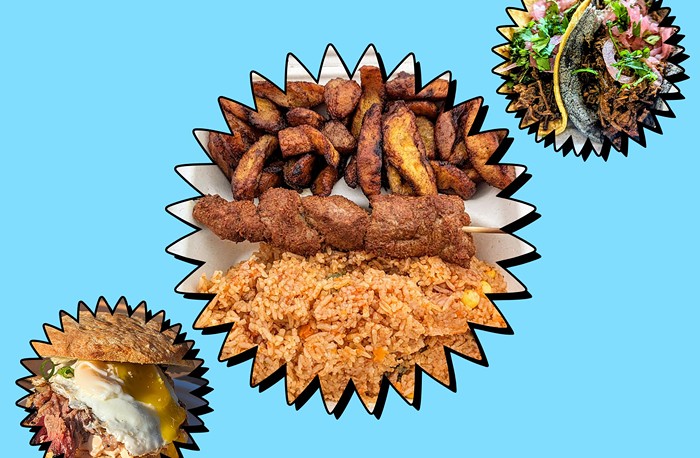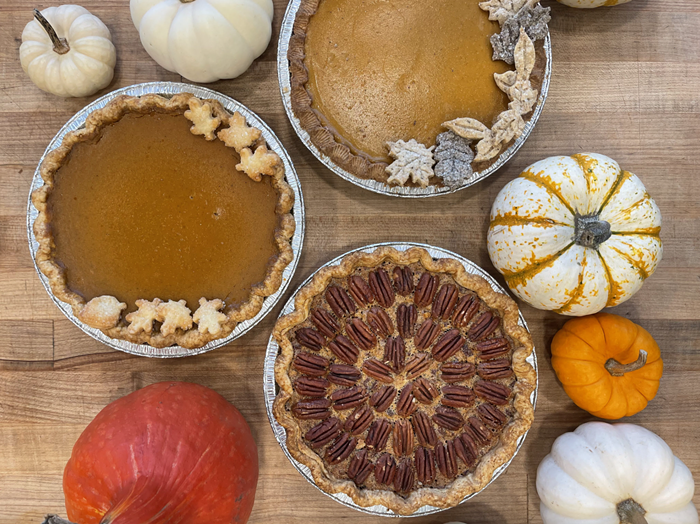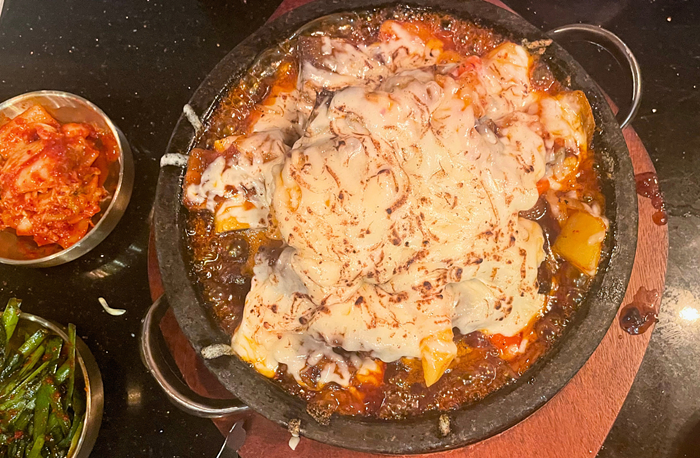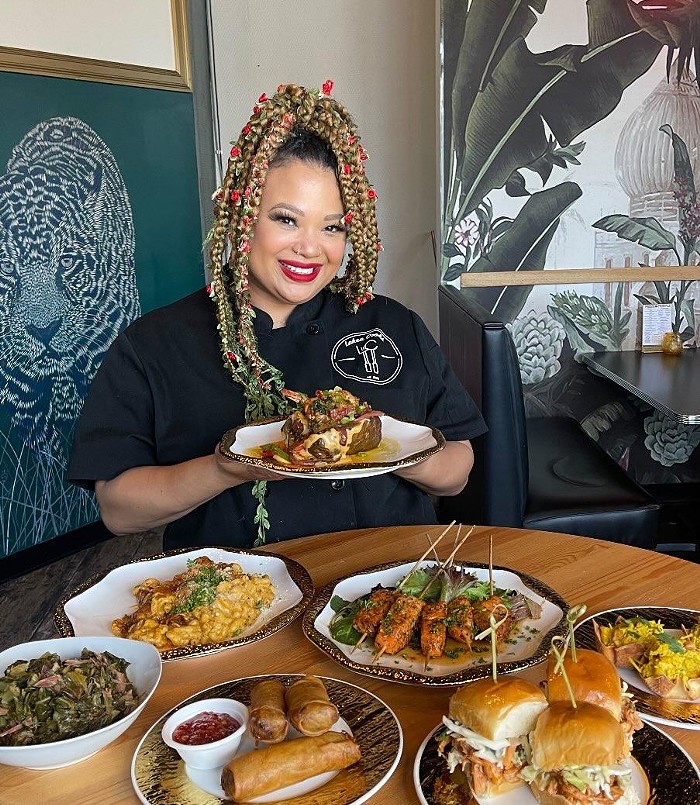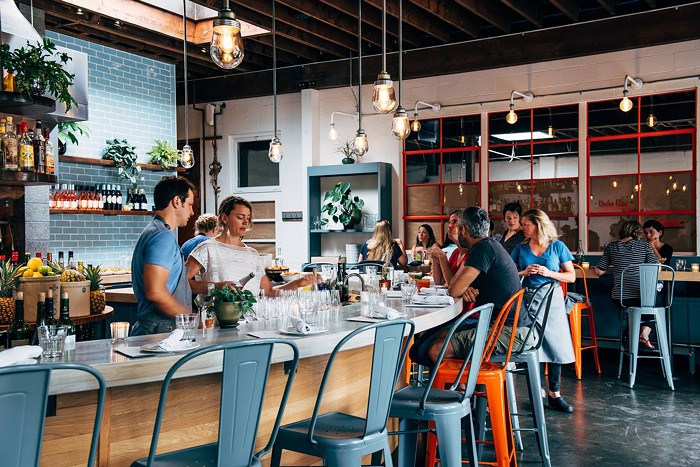The Fremont trolley barn is an old and famous local building. A major American public transportation system met its end here on April 13, 1941. According to the Seattle Times, the last streetcar did its rounds in the morning, pulled into the barn, stopped, and that was that—a system of over 400 electric cars and nearly 250 miles of track vanished like nothing more than the stuff in a dream. Later, the brick building housed Redhook Brewery, which moved to Woodinville in 2002, not long after being absorbed by the zaibatsu Anheuser-Busch. The terminal point for Seattle's transportation utopia is now the Theo Chocolate factory.
Today, people are in the factory waiting to see how chocolate is made—the imported bags of beans in the receiving room, the bulbous machines on the main floor, the pipes overhead; the crunching, crushing, heating, turning, cooling, and packing. Everyone is seated and listening to an introduction by a tour guide. Each head is covered by a blue hairnet—it is fitting to wear these delicate things in a chocolate factory, in the way it is fitting to wear a hard hat in a concrete factory.
In a hall leading from the visitors' room to the main processing area, an architect discusses with his client the plans for a redesign of the factory's interior spaces. At present, the building is mostly organized for the production and flow of nationally distributed chocolates, rather than the circulation of the ever-increasing number of visitors—between five and six tours are conducted daily, each with about 20 or so people who are eager to see how beans are transformed into bars.
In a small and crammed room next to the hall, I'm thinking: If I were British, I'd have the pleasure of calling the man sitting on the other side of the table my countryman. His name is Andy McShea. He is Theo's scientist. He joined the company after being blown to this corner of the world by the trade winds of his profession, biotechnology. He was born in the UK and worked in Austria, then Boston, then Seattle. Here, he was first employed by Fred Hutchinson Cancer Research Center, but he joined Theo the year it was founded, 2006, by Joseph Whinney, a social-minded entrepreneur. In the world of moviemaking, there's something called "development hell." You can spend years upon years making a living on a project that is never made. Something similar appears to exist in the world of biotechnology. You wait and wait, and then your project is bought up or abandoned. McShea decided this sort of thing was not for him, and he made a leap of faith from medicine to food.
On the table sits a jar, a bottle, and two wine glasses. McShea pours some of the bottle's contents into the glasses. We clink, and he explains to me that this is something new, an experiment, an alcoholic beverage. I take a sip. The sweet sip transports me to a pleasant scene: It's late in the evening, I'm in bed, an excellent detective novel is in my hands, the rain patters on the window. This is where and when I would most love to drink this light-brown liquid. I take another sip, and then another. "What is it made of?" I ask the scientist. "It's chocolate and nothing more."
McShea then pops open the jar and offers a taste of what looks like pudding. It is dark, rich, and deeply delicious. This, too, is an experiment.
"What you're eating is chocolate," McShea explains. "There's nothing else in it. It's chocolate with no additives. By looking at the material, and understanding its properties, we can do fun things with it... There's no reason in modern food, apart from cost accounting, to put all sorts of additives in it. What you're eating there is pudding that has no emulsifiers—which are very, very common. The reason our chocolate bars are different is they have no emulsifiers in them."
He refills our wine glasses: "We're trying to find ways to innovate by working with the properties of the existing material. Now, if we use this ridiculous crude-oil analogy, where we say: Why is crude oil valuable? Didn't we just used to set fire to the stuff? Well, it was better than setting fire to animal fat, which was the old thing. All of a sudden—what they did with crude oil—they sat there and they figured out things they could do with it that made the material intrinsically more valuable. Suddenly, it became much more valuable than it was before. The same is true with chocolate. There are simply very few people who have done a very good job of taking the raw material and using it for its various properties."
The laughter of visitors explodes in the adjacent room. He refills the glass. He continues: "It definitely drops blood pressure, that's as clear as day. It's a potent antibiotic, we've measured it. It definitely reduces inflammation, we've measured that. We've got a really good project going at the University of Washington with the department of dentistry. We've actually been looking at the effects of this stuff on gum tissue."
McShea seems never to have left the pharmaceutical world. Chocolate is not only delicious, it's medicinal. He is, however, not unaware of the downside of chocolate: "Dark chocolate is 44 percent fat—not a very nasty fat, but come on, guys, it's fat, whether you like it or not." But he believes in a chemistry that's committed to just chocolate, a faithful chemistry, a fidelity to natural materials. Unfaithful chemistry often diminishes or completely removes chocolate's positive properties.
My essential question: Was ist schokolade? McShea's answer: "It's basically wood. But the reason it tastes so good is it has a lot of plant polyphenol, and polyphenol is a multiringed polymer—it's like cellulose, but a little more digestible, and in the case of chocolate, there are a lot of sugars hanging on to that. And that's not normal. Normally it's a very fibrous material. And when you make chocolate, you start linking derived sugar and amino acid chemistry, and it all begins to taste very good."
This is what is original about McShea's approach to food: It combines the medicinal and political with the pleasures of consumption. ![]()



